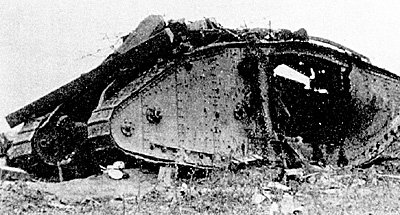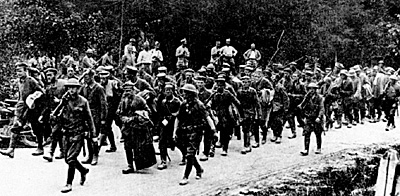In 1918, the Imperial German Army launched a series of offensive drives on the Western Front. Between March and August, the Germans surged forward in a desperate attempt to achieve a decisive military victory before infusions of American manpower could resuscitate the groggy Allies. Although successful at the tactical level, these attacks were not
well conceived strategically.
[11]
As a result, these "Ludendorff offensives" achieved only a meaningless advance of the German lines and fatally depleted the last reservoirs of German strength. In fact, they so exhausted the German Army that it was incapable even of consolidating its gains against Allied counterattacks from August onward. The Germans attributed the rapid collapse of
their defense after August 1918 primarily to demoralization and inadequate resources rather than to faulty doctrinal methods. As one German general later wrote, "Under such conditions, there could be no longer any mention of tactics" due to the chaotic state of the German armies. [12]
The Ludendorff offensives consumed the most combat-worthy divisions in the German Army. The German attacks were carried forward by specially designated "assault divisions." When the German offensives faltered, feeble "trench divisions," whose personnel and equipment were inferior to the assault units, assumed the burden of defensive operations. These trench divisions, which had been purposely starved of replacements to flesh out the shock divisions, turned out not to be merely second-rate but to be flatly "listless and unfit." [13]
Without support from the burned-out assault divisions, the trench divisions were unable to hold their own against the Allied counteroffensives. As the Allied counterblows gathered momentum, German morale plummeted, and German troops began to surrender in
unprecedented numbers. Under these circumstances, German small units could not be relied on to demonstrate the determination and aggressiveness essential to the Elastic Defense. [14]
Tank of the U.S. 27th Division destroyed by a German mine, September 1918
Ludendorff belatedly conceded that tank attacks "remained hereafter our most dangerous enemies. The danger increased in proportion as the morale of our troops deteriorated and as our divisions grew weaker and more exhausted."
[15]
Since the Germans had discounted the value of tanks, they had virtually none of their own with which to bolster the morale of their beleaguered infantry. [16]
The increasingly general use of tanks by the Allies prompted expedient
modifications to the Elastic Defense in the latter months of the war. When used by the Allies en masse, tanks could overrun single lines or even belts of antitank weapons. Consequently, the Germans distributed all types of antitank weapons in greater numbers throughout the depth of the battle zone, transforming it into a tank defense zone wherein enemy armor and infantry could both be destroyed.
[17]
These techniques successfully halted even heavy tank attacks, provided that the defending German infantry remained steadfast. As one German commander insisted, "The
infantry must again and again be made to realize that the tanks hardly deserve a battle-value
at all and that their threatening danger is overcome when the infantry does not permit itself
to become frightened by them."
[18]
German commanders exhorted their men to steel their nerves and to stand bravely
as had the "Teutons of old against the Romans." [19]
Brave words could not compensate for a lack of brave soldiers, however, and the "surrender bacillus" continued to rage through the German ranks.
[20]
Lack of sufficient manpower hurt the Germans as much as the lack of combat will. Because of losses in the Ludendorff offensives, the German
armies no longer disposed of sufficient reserves to deliver the timely counterattacks that the Elastic Defense required. Time and again, Allied penetrations prompted large-scale German withdrawals lest neighboring frontline units be encircled or enveloped from the enemy
salients. [21]
Too, the Allies (particularly the British) had refined their own offensive techniques, eschewing elephantine artillery preparations in favor of short, sharp barrages. Without the customary long artillery pounding that signaled Allied intentions, the Germans were less able to shuttle their few reserves to threatened sectors.
The German High Command finally bowed to the inevitable, and an armistice was enacted on 11 November 1918. In later years, many Germans allowed bitterness to cloud the memory of their defeat in the last months of World War I. Many high-ranking military officers blamed Germany's demise on a "stab in the back" by defeatist elements at home.
[22]
In reality, the Imperial German Army was in serious disarray from August 1918 onward and could not have prevented a complete Allied military victory. Frustration and Nazi demagoguery gave the stab-in-the-back story a certain currency during the interwar years, but the popular memory simply did not conform to historical reality.
The distorted memories of World War I left behind an uncertain and even
contradictory military legacy. Through four grim years, the conflict had been dominated by positional warfare. Consequently, the overriding recollection of the war on the Western Front was of entrenched stalemate, in which the first doctrinal priority was to assure a strong tactical defense.
In the German view, the war as a whole had been an attritional contest, ultimately decided by the superior weight of Allied manpower and resources. Unable to match the Allied coalition in either of these categories, the Germans had sought to maximize their own fighting power by doctrinal means. The Elastic Defense stood alone as the best system for conducting an effective positional defense at minimal cost. (Even the Allies testified to the superiority of the German techniques. The British, for example, attempted to incorporate the German defensive methods into their own postwar field service regulations. [23])
Consequently, a generation of German officers emerged from the Great War
steeped in the tactical precepts of the Elastic Defense. To these, the value of the Elastic Defense had been repeatedly assayed by tests in France and Flanders. On many fields, the Germans had successfully pitted defensive depth, firepower, maneuver, and aggressive counterattack against the brutish weight of Allied artillery, infantry, and even tanks. It was a tactical creed that was not to be forgotten.
Less clear, however, were the tactical lessons learned from the war's final months.
Then, positional warfare had briefly given way to battles of movement. The Ludendorff
offensives demonstrated the possibility of penetrating Allied trench defenses through attacks
by infiltration. The successful Allied counteroffensives from August 1918 onward showed
that perhaps even the Elastic Defense was not a perfect talisman against renewed maneuver
warfare, since weak and demoralized German forces could not turn away overwhelming
tank and infantry assaults through doctrinal charms alone.
However, most Germans excused the final Allied victories as being due to the prostration of German armies rather than to any failure of defensive doctrine.
Indeed, isolated examples of German defensive success right up until the armistice seemed to indicate that the Elastic Defense would have prevailed if determined troops had practiced it correctly.
 The tottering German forces were especially vulnerable to the shock effect of Allied tanks, particularly when used with chemical smoke. Looming out of the murk at close range, tanks often touched off epidemics of "tank fright."
The tottering German forces were especially vulnerable to the shock effect of Allied tanks, particularly when used with chemical smoke. Looming out of the murk at close range, tanks often touched off epidemics of "tank fright."
 American infantrymen escort German prisoners to the rear, 1918
American infantrymen escort German prisoners to the rear, 1918
Back to Table of Contents -- Combat Studies Research # 2
Back to Combat Studies Research List of Issues
Back to MagWeb Master Magazine List
© Copyright 2005 by Coalition Web, Inc.
This article appears in MagWeb.com (Magazine Web) on the Internet World Wide Web. Other articles from military history and related magazines are available at http://www.magweb.com